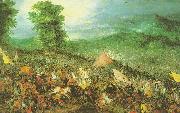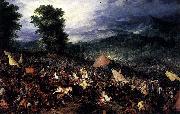Wholesale Oil Painting No Minimum |
|||||||||||
|
|
|||||||||||

|
|||||||||||
|
|
|
||||||||
Jan Brueghel1568-1625 Flemish Jan Brueghel Locations Jan Brueghel the Elder (b. 1568, Brussels - January 13th 1625, Antwerp) was a Flemish painter, son of Pieter Brueghel the Elder and father of Jan Brueghel the Younger. Nicknamed Velvet Brueghel, Flower Brueghel, and Paradise Brueghel, of which the latter two were derived from favored subjects, while the former may refer to the velveteen sheen of his colors or to his habit of wearing velvet. Bouquet, painted 1603. The Entry of the Animals Into Noah Ark, painted 1613.His father died in 1569, and then, following the death of his mother in 1578, Jan, along with his brother Pieter Brueghel the Younger (Hell Brueghel) and sister Marie, went to live with their grandmother Mayken Verhulst (widow of Pieter Coecke van Aelst). She was an artist in her own right, and according to Carel van Mander, possibly the first teacher of the two sons. The family moved to Antwerp sometime after 1578. He first applied himself to painting flowers and fruits, and afterwards acquired considerable reputation by his landscapes and sea-pieces. He formed a style more independent of his father than did his brother Pieter the Younger. His early works are often landscapes containing scenes from scripture, particularly forest landscapes betraying the influence of the master forest landscape-painter Gillis van Coninxloo. Later in his career, he moved toward the painting of pure landscapes and townscapes, and, toward the end, of still lifes. After residing long at Cologne he travelled into Italy, where his landscapes, adorned with small figures, were greatly admired. He left a large number of pictures, chiefly landscapes, which are executed with great skill. |
||||||||
|
|
||||||||
The Battle of Issus
The Battle of Issus Painting ID:: 230 |
1602
Musee du Louvre, Paris 1602 Musee du Louvre, Paris |
|||||||
|
|
||||||||
Jan Brueghel1568-1625 Flemish Jan Brueghel Locations Jan Brueghel the Elder (b. 1568, Brussels - January 13th 1625, Antwerp) was a Flemish painter, son of Pieter Brueghel the Elder and father of Jan Brueghel the Younger. Nicknamed Velvet Brueghel, Flower Brueghel, and Paradise Brueghel, of which the latter two were derived from favored subjects, while the former may refer to the velveteen sheen of his colors or to his habit of wearing velvet. Bouquet, painted 1603. The Entry of the Animals Into Noah Ark, painted 1613.His father died in 1569, and then, following the death of his mother in 1578, Jan, along with his brother Pieter Brueghel the Younger (Hell Brueghel) and sister Marie, went to live with their grandmother Mayken Verhulst (widow of Pieter Coecke van Aelst). She was an artist in her own right, and according to Carel van Mander, possibly the first teacher of the two sons. The family moved to Antwerp sometime after 1578. He first applied himself to painting flowers and fruits, and afterwards acquired considerable reputation by his landscapes and sea-pieces. He formed a style more independent of his father than did his brother Pieter the Younger. His early works are often landscapes containing scenes from scripture, particularly forest landscapes betraying the influence of the master forest landscape-painter Gillis van Coninxloo. Later in his career, he moved toward the painting of pure landscapes and townscapes, and, toward the end, of still lifes. After residing long at Cologne he travelled into Italy, where his landscapes, adorned with small figures, were greatly admired. He left a large number of pictures, chiefly landscapes, which are executed with great skill. |
||||||||
|
|
||||||||
|
|
The Battle of Issus
The Battle of Issus Painting ID:: 93663 |
1602(1602)
Medium oil on panel
Dimensions Height: 86 cm (33.9 in). Width: 135 cm (53.1 in).
cjr 1602(1602) Medium oil on panel Dimensions Height: 86 cm (33.9 in). Width: 135 cm (53.1 in). cjr |
||||||
|
|
||||||||
|
Jan Brueghel 1568-1625 Flemish Jan Brueghel Locations Jan Brueghel the Elder (b. 1568, Brussels - January 13th 1625, Antwerp) was a Flemish painter, son of Pieter Brueghel the Elder and father of Jan Brueghel the Younger. Nicknamed Velvet Brueghel, Flower Brueghel, and Paradise Brueghel, of which the latter two were derived from favored subjects, while the former may refer to the velveteen sheen of his colors or to his habit of wearing velvet. Bouquet, painted 1603. The Entry of the Animals Into Noah Ark, painted 1613.His father died in 1569, and then, following the death of his mother in 1578, Jan, along with his brother Pieter Brueghel the Younger (Hell Brueghel) and sister Marie, went to live with their grandmother Mayken Verhulst (widow of Pieter Coecke van Aelst). She was an artist in her own right, and according to Carel van Mander, possibly the first teacher of the two sons. The family moved to Antwerp sometime after 1578. He first applied himself to painting flowers and fruits, and afterwards acquired considerable reputation by his landscapes and sea-pieces. He formed a style more independent of his father than did his brother Pieter the Younger. His early works are often landscapes containing scenes from scripture, particularly forest landscapes betraying the influence of the master forest landscape-painter Gillis van Coninxloo. Later in his career, he moved toward the painting of pure landscapes and townscapes, and, toward the end, of still lifes. After residing long at Cologne he travelled into Italy, where his landscapes, adorned with small figures, were greatly admired. He left a large number of pictures, chiefly landscapes, which are executed with great skill. The Battle of Issus 1602(1602) Medium oil on panel Dimensions Height: 86 cm (33.9 in). Width: 135 cm (53.1 in). cjr |
||||||||
|
|
||||||||
|
Prev Next
|
||||||||
|
|
||||||||
|
Related Paintings to Jan Brueghel :. |
||||||||
|
|
||||||||
|
CONTACT US |


